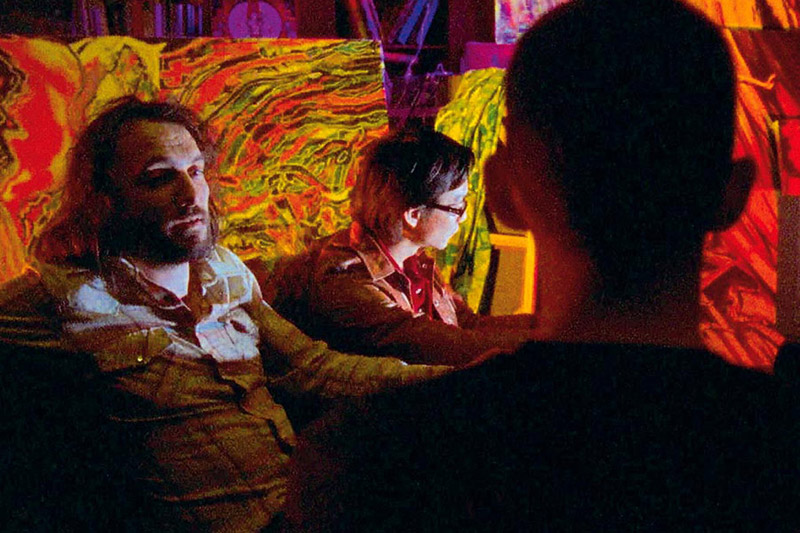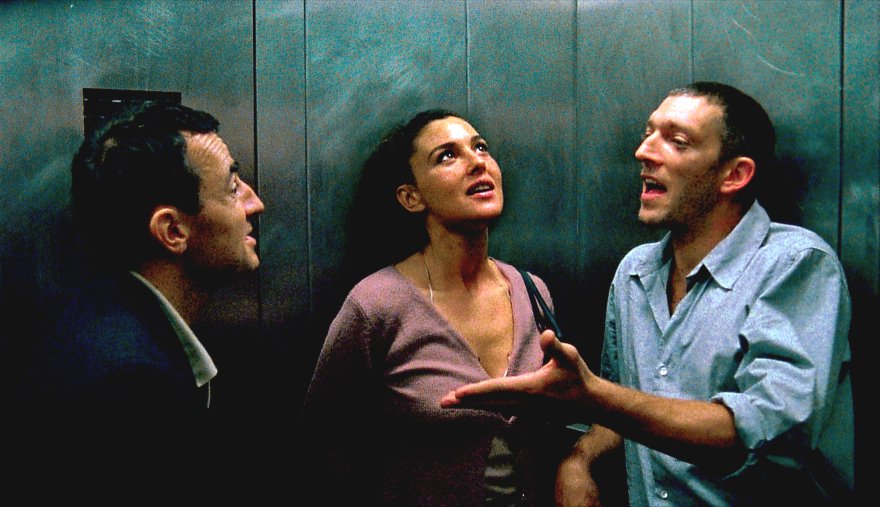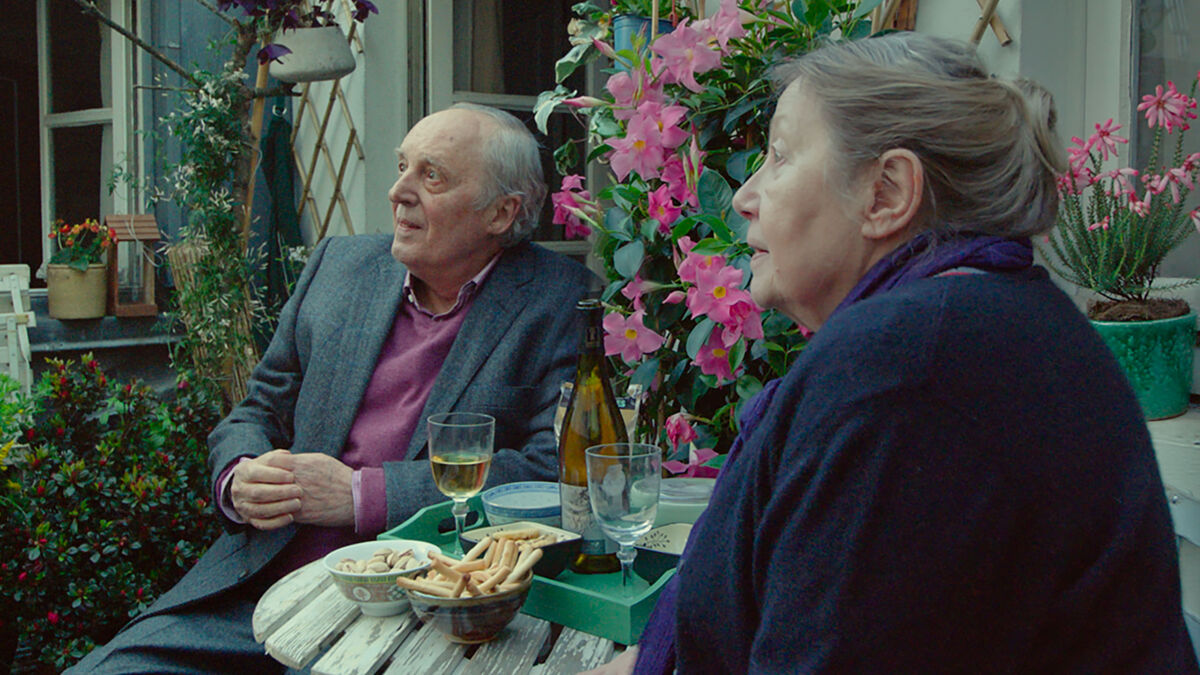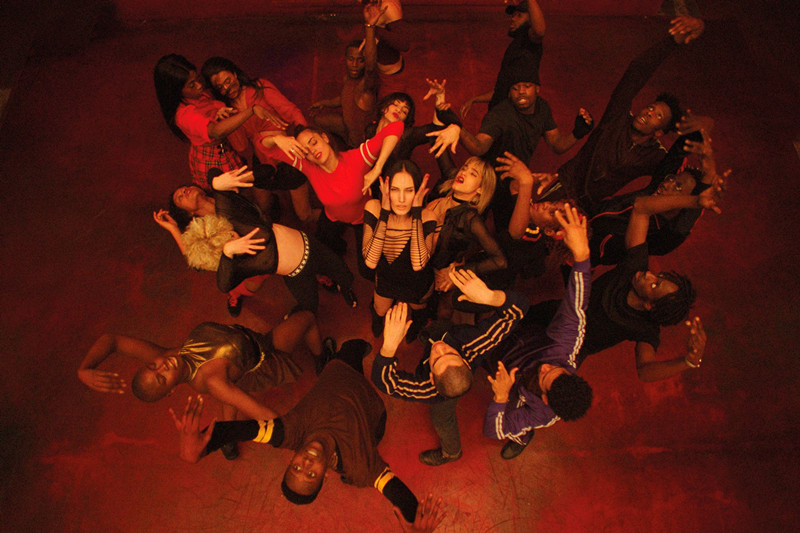4. Enter the Void (2009)

You know what you are getting into just from the opening credits of this film. Strobing titles that would jump start an epilectic seizure in different and multiple fonts. Hard-hitting acid-techno slams its way into your eardrums. Colors and lights splash onto your face and singe your eyes. If you close your eyes you will still see the imprint of the text below your lids. You are being sent off into the depths of a psychedelic horror movie. Noe rarely removes the camera from its set positions in the film. A first person POV, a third person POV and an omniscient, floating camera that sees everything. These choices are deliberate and each depict a different period of time of life.
Inspired by the Bardo Thodal or Tibetan book of the dead, the main character witnesses life after dying while tripping on the psychedelic drug DMT. He sees what his life has led to and what life for his loved ones descend to after his passing. ENTER THE VOID is an experience through trauma. Seeing the past allows us to make sense of the present and future.
A feast for the eyes, visual candy sweetened by vivid, color soaked frames, Gaspar Noe and cinematographer Benoit Dubie take their style to another level.. Recreations of DMT hallucinations explode into fractal fireworks, stimulating our senses and our minds. But the visuals are only the beginning.
Noe’s instinct to shock is still apparent in ENTER THE VOID. He frequents the use of incest and ramps it up to 10 in this, which is extremely off-putting. This is probably his intent, but he doesn’t stop there. Scenes of sleazy mother fucking, drug-taking, abortions, police violence – Gaspar Noe is throwing the kitchen sink of vile and bile at the audience. The seedy underground neon lit club scene backdrop is also in full steam as this is the movie that went on to cement his visual style. Hard hitting techno music phases through your ears creating this strung out, druggy atmosphere feeling both energetic and drowsy that can only be accompanied with gunshots and police sirens. It is an ambitious feat for Noe, but one that isn’t harmonious.
A glaring flaw in the movie is the acting and unfortunately that’s what keeps it from a higher rank on this list. The acting in it is sub-par, especially our main character. Noe’s trouble directing in English is as apparent in this as it is in LOVE. But in ENTER THE VOID, it is more forgiving because of the immersive power of the film. You could make a case that the main character is this drugged out addict. The monotonous slurring and stilted speech pattern is believable when you put it in that context, though that seems like a justification of a poor performance. The technical execution of this film is stunning, but ultimately questionable acting, unnecessary conversations that bog down the pace, and mixed messages throughout the movie hold it back from being his masterpiece. At nearly 3 hours long, this movie could have used fine tuning. If only he could have kept all of the plates spinning.
3. Irreversible (2002)

Appearing on lists of shocking and disturbing movies, people are often caught off guard when they realize this non-linear story has tender and authentic components to it. Not many, but definitely more than one would expect. It marks a massive leap in Noe’s directorial capability not only being more carefully and deliberately constructed than his debut, I STAND ALONE, but finally taps into his personal expression and constructs a unique style and uncompromising vision.The film is in reverse order but it is still coherent, disorienting, yes, but in a way that has intent. The juxtaposition of one scene to the next, from a conversation to an action or from a reaction to a complete opposite emotion flows seamlessly and was done deliberately. Noe uses sex and physicality to dissect the human condition through its broad spectrum ranging from tenderness to animalistic while also using his style to create realistic but surreal scenes.
It starts with one of his trademark disorienting and exciting title sequences, the scrolling words off-kilter, spinning then seamlessly transitioning to the camera doing the same things. The camera often drifts into back alleys and is washed with red light, connecting one scene to another. Thomas Bangalter, of Daft Punk, creates a soundscape of droning, disorienting shepard’s tones, a feeling of repetitive falling like you are about to drown into a dream or in this case — a nightmare. Impending doom sits above the watcher like a rumbling thundercloud about to burst. Elements that cannot be stopped.
We see the events of one crazy drug-induced nightmare night from its end point all the way to the beginning. It is doomed from the start, but even more so than that, the movie is expository. Below the surface of violent imagery sits a plethora of themes ready for dissection. It exposes how our idea of happiness is directly related to the rules of society and how those rules are completely made up. How one event can cause people to spiral down a path that strips them of what is considered to be human.
IRREVERSIBLE could be considered Noe’s deepest film where the actions and the underlying meanings lock into place like a jigsaw puzzle. One could say his most inspired film. Where authenticity is ubiquitous with style. Where horrifying acts scar and are not glorified and actions have consequences. Characters change, albeit in reverse, and morals are questioned. All the moving parts, be it sound, production design, cinematography, editing, end up merging together working in harmony. There is a cut of this film that is played out in chronological order, but stay away. It takes a very important statement out of the movie: we are doomed to our fate.
2. Vortex (2021)

A departure from his previous work, VORTEX feels like a movie from an artist that has matured from one version of disturbing to another. Graduating from visceral, physical, violent horror to one that is subtle, creeping and silent, but just as bleak. A sickly elderly couple spend their last days together, slowly drifting apart both mentally and physically.
It is a grueling movie to get through. Depression oozes from every split frame, their frustrations with each other so real that you want to look away. A lot of screen time is devoted to them separated from each other, but in similar positions. Almost exact positions in different locations. Both of them are going through illness, one of the brain and the other of the heart. Things get even more complicated when their son, a troubled filmmaker, gets involved and tries to sort out their situation. Things are not as simple as they appear to be. Slow reveals unravel each character and spill another thread that complicates the core problem. Be it a lost love, or drugs, both recreational and pharmaceutical, but then again Noe makes a good point – what’s the difference?
The pace is a far cry away from his normal work. It is slow, some would say lethargic. Using the split screen that he first introduced in his filmography with LUX AETERNA, VORTEX allows us to capture the confusion and horror of both of its characters simultaneously. Dueling cameras track characters from opposite sides, the movement converging in the middle, hypnotizing the audience.
Two different stories playing simultaneously making them one and the same. The amount of coordination in this movie is baffling. The two cameras, the characters, everything dance in harmony. Characters cross each other’s streams and get picked up by the nearest camera changing which side of the screen they are on. They run concurrently so actions that start on one camera bleed into the next, distorting limbs and features occasionally, sometimes splitting overwhelmed characters in two. A very well utilized Noe-ism is used to its full potential in this – the screen flashes black for a frame or two to create a more seamless edit.
The movie feels as if you are looking through a stereoscope, flashing through two lives that are together but so separate. It also feels like a call back to silent films, Noe weaves the thread of film history throughout, a call to the muses and masters of the past. Relevant audio from TVs that we cannot see and radios in the distance echo profound philosophical speeches that add to the themes Noe is aiming his sights on.
The writer is writing a book about film and dreams. He intends to call it Psyche. It is fitting that legendary director Dario Argento plays this passionate cinephile dissecting his thoughts on film. Noe is using this book to tell us his own philosophy. How film and dream are hand in hand, which is not too far from what modern scientists say. But it goes one step further. Noe is stating that experience itself, life itself, is a dream. He quotes Edgar Allen Poe: “Is all that we see but a dream within a dream?” The characters live in the reality that they create themselves, whether that is conscious or unconscious and each actor puts in performances that are nothing short of completely realistic.
The horror of VORTEX comes from within, from the uncontrollable and the inevitable, as Noe tends to depict. What really makes it terrifying is the loss of reality, the loss of your experience. How a previously intelligent person turns into a sputtering, terrified shell of a human being. How a strong, proud man can wither into fragile dust. A once loving and trusted relationship turns into paranoia. After all, one simple mistake can cause a lot of damage. Mental anguish can hurt more than physical pain, however it is the physical that keeps one alive. And that is the horror. Our bodies can fail at any moment without giving us any signs or any cures. It can just happen. The juxtaposition of the visuals and sound at the end evoked a feeling of existential dread that only a few movies have tugged at before.
VORTEX is tender and introspective. Paraphrasing a line that is both haunting and reaffirming: “illness is not our fault.. it is fate.” In many ways, this is Noe’s most authentic film. Maybe even his best, but it is not for everybody. VORTEX is a slice of life – quiet, heartbreaking, thought provoking and meditative. Truly a piece of art.
1. Climax (2018)

CLIMAX is the amalgamation of Gaspar Noe learning from his film making experience and optimizing his style in a way that is smaller, but more focused and authentic. More claustrophobic. After someone spikes the sangria at a dance troupe’s party, the participants start to lose their minds one by one.
Noe expertly uses pace in order for the audience to understand each character and what their motivations are within the dance troupe itself. He hooks the audience in with a woman dragging herself along the empty white void of a snow covered field. Then he cuts and isn’t afraid to slow it down. He knows that he’s plunged his hooks into the audience. He’s bought his time. Extended two shot scenes of conversations between cliques in the troupe allow us to understand where they stand both within the group and philosophically. We begin to form relationships between the characters and see their relationships to others. Then… they dance.
He establishes the problem very methodically. We get more character development and more setups that are almost invisible due to their conversational nature. Noe loves to plant ideas in the form of dialogue and it is apparent throughout his filmography. In some movies it comes off as clunky, but it shines when he gets realistic performances out of his actors. People start drinking the sangria, talking to each other and trying to enjoy their party. Slowly, the effects start to come on. The mesmerizing sounds of his collaborator Thomas Bangalter once again signals a point of no return. Things seem off. People are dazed, swaying, trying to figure out what is going on.
Coordination between visuals and sound are the cogs in which the machine of film runs on. That is why the music video can be so powerful. Cutting to music can be a very visceral experience. But Noe refrains from that. In one unbroken take, he relies on physicality to channel the energy from the playing music. Dance, being a cinematic artform in itself, is used to show harmony within the group. Vicious flailing, graceful spins, jumps and slithering trigger in unity with the music. But when they all get into their own heads and dance by themselves, we innately understand that there is a disconnect between the troupe.
There is a point in the film where you will not notice any cuts. Noe has come out and said that it is a 42 minute long take. You barely notice. The camera spins slowly, just enough to be noticed. Just enough to get you off of your balance. He again uses physicality and performance as a tool to enhance surrealistic imagery and expression of the characters’ inner state. A contortionist deforms his arms like a pretzel inside of a trance as horrific events play out as if nothing else exists except the dance and him. Sofia Boutella goes on an acid-trance screaming tirade of pure emotion only equal to Andrej Zulawski’s POSSESSION where Isabel Adjani flails around in a subway.
Instead of using visuals to experience what the characters are seeing, such as in ENTER THE VOID, we only see behavior — accurate behavior — of an unexpected psychedelic trip. Those who have had bad trips on psychedelics will cringe in anxiety. For those who haven’t, they may never want to try. Noe develops his characters and their relationships before sending them off in a paranoid frenzy. Things escalate at such a pace that your heart can’t keep up. The characters can’t as well, wandering around the enclosed space, terrified at what is happening in front of them.
As in any psychedelic trip, music is very powerful in manipulating emotion. French house and techno dictate the emotional waves of the film. In another collaboration with Thomas Bangalter and subsequently his duo Daft Punk, Noe uses music to manipulate not the audience but the characters. The grating Rollin’ and Scratchin’ is featured in one of the film’s emotional high points, a synthetic banshee scream heightening the tension when the troupe turns on one of its own.
Noe again uses the taboo and the disturbing to torture his characters and hypnotize the audience. Though he can’t stay away from his incestual fixation, he adds a little more tasteful depth into it. Events keep ramping up and up until it explodes in a cacophony of anxiety. After a point in the film, you cannot help but to watch. Every event seems like a disaster, until ultimately we start back at the beginning.
CLIMAX is not only Gaspar Noe’s most accessible film, but the film that fires on all cylinders, using every technique that he has established to its fullest, creating a claustrophobic microcosm of his own style. And that’s why it ranks number one on this list.